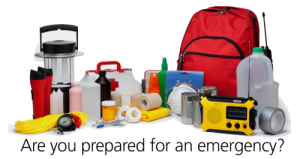Emergency Preparedness & Supply Kit
Are you prepared? Emergency preparedness is a topic that everyone should be informed about. This is not a topic only for people who live in areas that have  frequent earthquakes, hurricanes, and/or tornados. Every person and every home should be prepared for an emergency. The Safety Education Alliance of America recommends the following ideas of how to plan for an emergency:
frequent earthquakes, hurricanes, and/or tornados. Every person and every home should be prepared for an emergency. The Safety Education Alliance of America recommends the following ideas of how to plan for an emergency:
- Discuss with your family the various types of disasters that can occur where you live.
- Develop an emergency home evacuation plan and practice the plan with your family at least twice per year.
- Utility valves, such as electricity, water and gas, may need to be shut off during an emergency.
- A list of contact information should be prepared for your household. Include names and phone numbers of local relatives, as well as out-of-town contacts.
- Have a map of your neighborhood available to help guide you to emergency shelters and other emergency sites.
- A carbon monoxide detector should be on each floor near sleeping areas.
- In the event of an emergency, be a good neighbor and check in on anyone with special needs, including elderly neighbors, people with disabilities, and children who are home alone.
- Prepare a disaster supply kit today. What you have in your kit can make a big difference – even save a life. Plan enough supplies for each person in your household for a minimum of three days.
Emergency supply items, as recommended by the Safety Education Alliance of America and the American Red Cross include:
- Water, Food
- First Aid Kit, Medications
- Flashlight, Whistle
- Battery-operated Radio
- Tools, Compass, Map
- Clothing, including sturdy shoes, jacket, raincoat, and gloves
- Important Information, such as copies of ID cards, birth certificates, insurance policies, and passports
- Cash and Personal Items, such as eyeglasses, books, toys and games for the kids
- Sanitary Supplies and Pet Supplies
- Contact Information (list of family names/numbers)
- Be sure to include any other necessary items for seniors and disabled individuals.
As you gather your supplies and important information, place them in a sturdy, easy to carry container or backpack. To learn more about preparing for disasters and emergencies, visit the Safety Education Alliance of America and the American Red Cross websites.
















